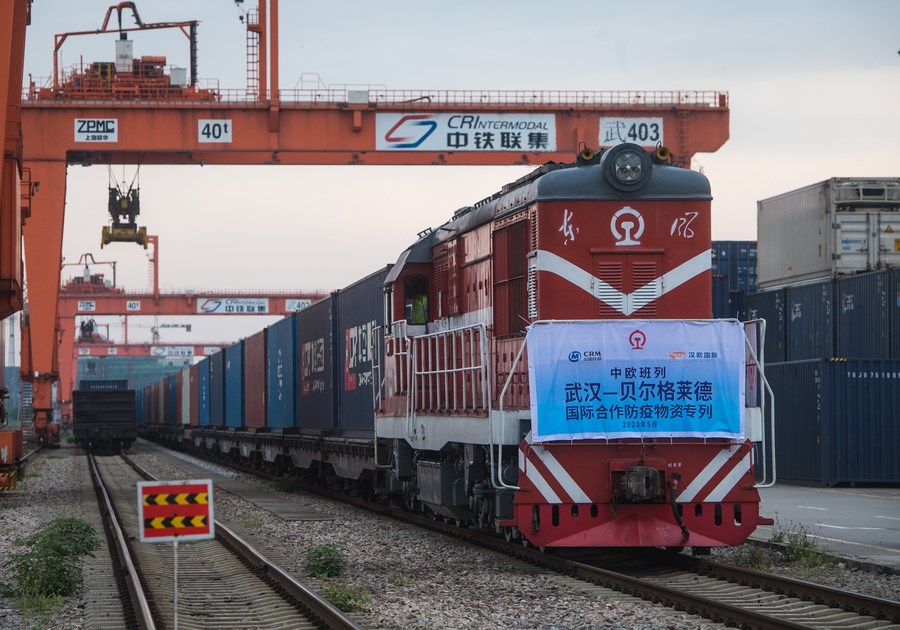China seeks policy mix to boost economic resilience
Aware of the challenges at home and abroad, China has been seeking a policy mix featuring diversified monetary tools, fiscal support and a firm commitment to opening-up to keep the economy running within an appropriate range.
Aware of the challenges at home and abroad, China has been seeking a policy mix featuring diversified monetary tools, fiscal support and a firm commitment to opening-up to keep the economy running within an appropriate range.
Owing to a low comparison base and consolidating recovery, China's economy expanded 12.7 percent year on year in the first half of 2021, but the evolving COVID-19 pandemic and unbalanced domestic rebound still call for more attention on downward pressures.
Noting the headwinds in a key meeting last week, the Political Bureau of the Communist Party of China (CPC) Central Committee stressed the need to maintain consistent, stable and sustainable macro policies, and sound coordination to mesh this year's policies with those for 2022.

Photo taken on May 8, 2021 shows different kinds of alcoholic drinks on display during the first China International Consumer Products Expo in Haikou, south China's Hainan Province. (Xinhua/Yang Guanyu)
CROSS-CYCLICAL ADJUSTMENT
The meeting emphasized "cross-cyclical adjustment" in macro-economic policies, a term analysts interpreted as a focus on boosting economic resilience in the short term while allowing policy leeway for future uncertainties.
The proactive fiscal policy should generate a greater effect, while the prudent monetary policy should maintain reasonably ample liquidity and support the continued recovery of small and medium-sized enterprises as well as industries under stress.
"We believe that policies will become more discretionary, and we should not expect rapid policy relaxation in the near term," said a research note by China International Capital Corporation Limited (CICC).
China's central bank in July cut the reserve requirement ratio (RRR) by 50 basis points for eligible financial institutions to drive down financing costs and boost the real economy.
Nomura Securities believes that the probability of another universal RRR cut is limited, and the central bank may prefer the use of low-profile tools to inject long-term liquidity.
On the fiscal front, the issuance of government bonds has been relatively slow this year as the relatively strong economic momentum has reduced the need for fiscal support.
"We think the issuance quota of local government bonds may remain underused in 2021, and the issuance may continue towards early 2022 to support economic growth in early next year," said the CICC report.

China-Europe freight train carrying anti-epidemic supplies leaves for Belgrade, Serbia from Wuhan, central China's Hubei Province, May 9, 2020. (Xinhua/Xiao Yijiu)
HIGH-LEVEL OPENING-UP
The CPC leadership meeting reiterated China's commitment to high-level opening-up and the high-quality development of the Belt and Road Initiative.
"China is well equipped with the conditions for promoting high-level opening-up," said Zhou Maohua, an analyst with the China Everbright Bank, citing the country's deepening supply-side structural reform and more mature supervision laws and regulations.
Since the beginning of 2021, the country has expanded its opening-up with concrete measures. In July alone, China pledged proactive efforts toward a higher level of financial openness based on a negative list approach, issued a guideline to support high-level reform and opening-up of the Pudong New Area in Shanghai, and released a negative list for cross-border trade in services in its southern island province of Hainan, the first negative list for services trade in the country.
Despite a complex and severe external environment, China's economic and trade cooperation with other countries and regions is thriving. Analysts believe the momentum will continue as the economy generates more opportunities with its doors opening wider.
The country's foreign trade navigated epidemic-induced challenges to become a major support to the international logistics supply chain in the first half of this year. The China-Europe freight train service, a window to the transcontinental trade, handled 7,377 trips, up 43 percent from the same period last year. Around 94,000 tonnes of anti-pandemic supplies were shipped through the route as of late June, reinforcing the global fight against the COVID-19 pandemic.
During the period, the growth rate of China's trade value with its top three trading partners -- the Association of Southeast Asian Nations, the European Union, and the United States -- stood at 27.8 percent, 26.7 percent and 34.6 percent, respectively, official data showed.
China's trade with countries along the Belt and Road rose 27.5 percent year on year to stand at 5.35 trillion yuan (827.5 billion U.S. dollars), while trade with countries of the Regional Comprehensive Economic Partnership grew 22.7 percent year on year.
Foreign investors have continued to cast a vote of confidence in the country's opening-up. In the first half of this year, foreign direct investment into the Chinese mainland, in actual use, jumped 33.9 percent year on year to 91 billion dollars, the highest growth pace in almost 10 years, according to the commerce ministry.

